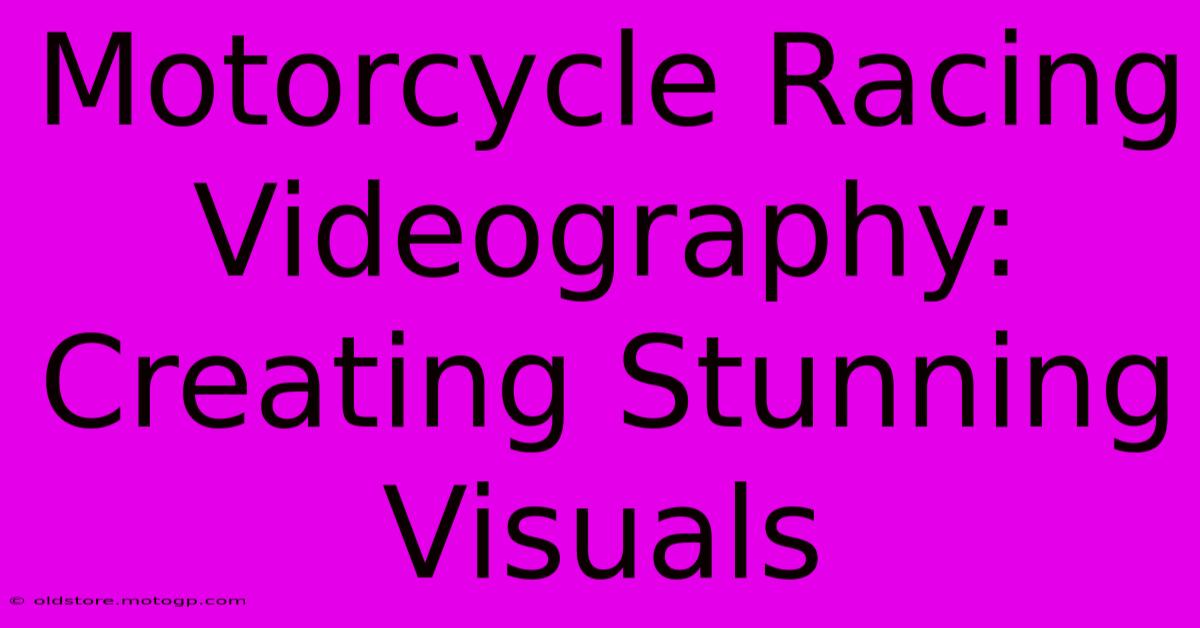Motorcycle Racing Videography: Creating Stunning Visuals

Table of Contents
Motorcycle Racing Videography: Creating Stunning Visuals
Motorcycle racing is a spectacle of speed, skill, and adrenaline. Capturing this intensity on film requires more than just pointing a camera; it demands a strategic approach to videography that delivers stunning visuals and truly captures the essence of the sport. This guide dives into the techniques and equipment necessary to create captivating motorcycle racing videos.
Mastering the Art of Motorcycle Racing Videography
Whether you're a seasoned professional or an enthusiastic amateur, capturing compelling footage of motorcycle racing requires a blend of technical expertise and artistic vision. Let's break down the key elements:
1. Choosing the Right Equipment
Investing in high-quality equipment is paramount. The fast-paced nature of motorcycle racing demands cameras capable of capturing sharp, clear images even in challenging conditions.
-
Cameras: Consider cameras with high frame rates (at least 60fps, ideally 120fps or higher for slow-motion shots) and excellent low-light performance. Action cameras like GoPro HERO11 Black or similar models are popular choices due to their durability and versatility. Larger professional cameras like those from Canon or Sony offer superior image quality but require more stability solutions.
-
Lenses: Wide-angle lenses are crucial for capturing the sweeping landscapes and the overall action. Telephoto lenses allow you to zoom in on specific racers and details, providing close-up shots of the intense moments.
-
Audio: Clear audio significantly enhances the viewing experience. Invest in a high-quality external microphone to capture the roar of the engines and the atmosphere of the race. Consider wind protection for your microphone to minimize unwanted noise.
-
Stabilization: Smooth footage is essential. Use a gimbal for handheld shots or consider mounting your cameras on stable tripods or specialized motorcycle mounts for steady, professional-looking results.
2. Strategic Camera Placement & Angles
The placement of your cameras is key to capturing dynamic and engaging footage. Experiment with various angles to provide a diverse perspective of the race:
-
Trackside Shots: Position cameras along the track to capture the bikes speeding past, showcasing their speed and power. Varying heights and angles here creates dynamic visuals.
-
Onboard Cameras: Mounting cameras on the bikes themselves (with rider permission and safety precautions!) provides an immersive, visceral experience for the viewer, placing them right in the heart of the action.
-
Drone Footage: Drone shots provide breathtaking aerial views, showcasing the entire track layout and the positioning of the racers. Remember to adhere to all drone regulations and obtain necessary permissions before flying.
-
Close-ups: Capture detailed shots of racers' faces, their body language, and the mechanical details of the bikes. These shots add a human element and enhance emotional impact.
3. Editing Techniques for Maximum Impact
Post-production is where your footage transforms into a captivating story. Employ these editing techniques to maximize the impact of your motorcycle racing video:
-
Slow-Motion: Use slow-motion footage to highlight key moments, showcasing the precision and skill of the racers.
-
Fast-Motion: Employ fast-motion to compress lengthy stretches of the race, creating a dynamic and exciting sequence.
-
J Cuts & L Cuts: These sophisticated editing techniques create a seamless flow between shots and maintain viewer engagement.
-
Music & Sound Effects: The right soundtrack enhances the emotional intensity and excitement of the video. Select music that complements the fast-paced nature of the race.
-
Color Grading: Refine the color palette of your video to create a consistent and aesthetically pleasing look.
4. Safety First: Prioritizing Safety on Race Day
Remember that safety is paramount. Always follow track rules and regulations. If filming on a professional track, communicate with officials and obtain necessary permissions. When using drones, always abide by local regulations and ensure you are flying safely and legally. Never endanger yourself or others while filming.
5. Marketing Your Motorcycle Racing Videos
Once you've created stunning visuals, share them with the world! Utilize social media platforms like YouTube and Vimeo to showcase your work. Engage with viewers in the comments and consider using relevant hashtags to increase visibility.
By mastering these techniques and prioritizing safety, you can create captivating motorcycle racing videos that capture the raw energy and excitement of this thrilling sport. Remember to practice, experiment, and constantly refine your skills to elevate your videography to the next level.

Thank you for visiting our website wich cover about Motorcycle Racing Videography: Creating Stunning Visuals. We hope the information provided has been useful to you. Feel free to contact us if you have any questions or need further assistance. See you next time and dont miss to bookmark.
Featured Posts
-
Motorcycle Racing And Philanthropy Giving Back To The Community
Feb 19, 2025
-
Motorcycle Racing And Tourism Experiencing The World Through Racing
Feb 19, 2025
-
Moto 2 Specs The Complete Guide
Feb 19, 2025
-
The Heart Of Cota General Admission Experience
Feb 19, 2025
-
The Ultimate Guide To Free Moto Gp Live Streams
Feb 19, 2025
